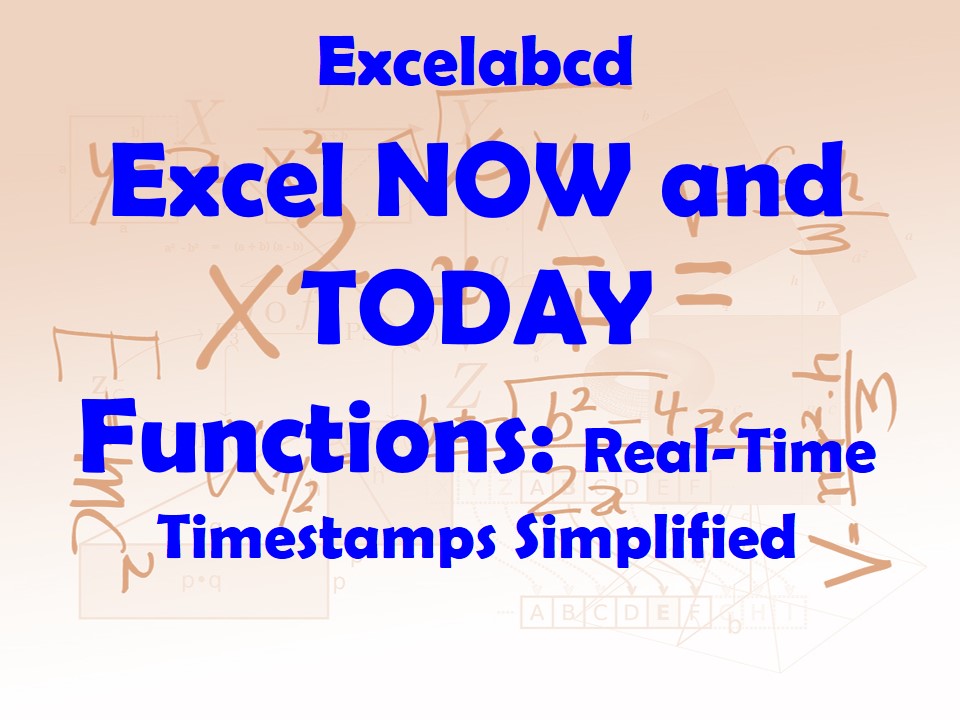Lesson#237: Excel NOW and TODAY Functions: Real-Time Timestamps Simplified

In the dynamic world of Excel, tracking real-time information is often crucial. The Excel NOW and TODAY functions are your trusty companions for creating real-time timestamps that update automatically. These functions are indispensable when you need to keep records of when data was entered, monitor project timelines, or simply keep tabs on the current date and time. In this expert-level guide, we’ll delve into the nuances of the NOW and TODAY functions, providing you with in-depth insights and a multitude of practical examples – ten in total – to become a real-time timestamp pro in Excel.
Understanding the NOW and TODAY Functions
Before we dive into practical examples, let’s grasp the fundamental concepts of the NOW and TODAY functions:
- NOW(): This function returns the current date and time as a serial number. It updates automatically whenever the worksheet recalculates.
- TODAY(): This function returns the current date as a serial number. Like NOW, it also updates automatically when the worksheet recalculates.
Now, let’s explore these functions in action with practical examples.
Examples of the NOW Function
Example 1: Real-Time Timestamp
Let’s start with the most basic usage. To display the current date and time in a cell, simply use the NOW function like this:
=NOW()This formula will constantly update to reflect the current date and time whenever your worksheet recalculates.
Example 2: Separating Date and Time
Suppose you want to display the current date and time in separate cells. You can use the NOW function like this:
- Cell A1:
=NOW() - Cell B1:
=TEXT(A1, "dd/mm/yyyy") - Cell C1:
=TEXT(A1, "hh:mm:ss")
Cells B1 and C1 will contain the current date and time, respectively.
Example 3: Timestamp on Data Entry
To automatically timestamp when data is entered into a cell, you can use an Excel event macro with the NOW function. This will update a cell with the current date and time whenever data is entered into another cell. Here’s a simplified example:
Private Sub Worksheet_Change(ByVal Target As Range)
If Not Intersect(Target, Range("A1:A100")) Is Nothing Then
Target.Offset(0, 1).Value = Now
End If
End SubIn this VBA code, if data is entered in cells A1 to A100, the adjacent cell (one column to the right) will be populated with the current date and time.
Example 4: Conditional Formatting with Timestamps
You can use the NOW function in combination with conditional formatting to highlight rows where data has been recently updated. For instance, if data is in column A, you can create a conditional formatting rule for cell A1 like this:
=AND($A1<>"", NOW()-$A1<30)This rule will highlight rows where data was entered or modified within the last 30 minutes.
Example 5: Tracking Response Times
Suppose you’re tracking response times for customer inquiries. You can use the NOW function to calculate the time elapsed between inquiry creation and response. In cell B1, you have the inquiry creation timestamp (e.g., “01/01/2023 14:00”), and in cell C1, you have the response timestamp. Use this formula in cell D1 to calculate the response time:
=C1-B1This will display the time elapsed in days and fractions of a day.
Examples of the TODAY Function
Example 6: Simple Date Stamp
To display the current date in a cell, use the TODAY function like this:
=TODAY()This formula will constantly update to reflect the current date whenever your worksheet recalculates.
Example 7: Age Calculation
You can use the TODAY function to calculate ages. If you have birthdates in column A (e.g., “01/01/1990”), you can calculate ages in column B with this formula:
=TODAY()-A1This will display the age in days, but you can format it as years for better readability.
Example 8: Expiry Date Tracking
Suppose you’re tracking product expiry dates, and you have the expiry dates in column A (e.g., “12/31/2023”). You can use conditional formatting to highlight expired products. Create a rule with this formula:
=TODAY()>A1This will highlight rows where the expiry date has passed.
Example 9: Countdown to an Event
If you’re counting down to a future event, you can calculate the days remaining with the TODAY function. Let’s say the event date is in cell A1 (e.g., “12/31/2023”). Use this formula in cell B1:
=A1-TODAY()This will display the number of days remaining until the event.
Example 10: Ageing Receivables
In accounting, it’s common to track the age of receivables. If the invoice dates are in column A, you can calculate the aging in column B using the TODAY function. For example:
=TODAY()-A1This formula will display the age of each receivable in days.
Conclusion
The Excel NOW and TODAY functions are invaluable tools for creating real-time timestamps that automatically update. By understanding their usage and exploring these practical examples, you can efficiently manage dynamic data, automate timestamping, and perform time-related calculations with ease. Whether you need to track project timelines, record data entry timestamps, or monitor product expirations, NOW and TODAY are your reliable companions for real-time data management in Excel.
Leave a Reply